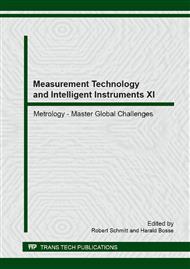[1]
Mannheim, T., Riedel, M., Hüsing, M. and Corves, B.: A new way of grasping: Paragrip - the fusion of gripper and robot, Grasping in Robotics, Springer, section 17, (2013).
DOI: 10.1007/978-1-4471-4664-3_17
Google Scholar
[2]
Müller, R., Riedel, M., Vette, M., Corves, B., Esser, M., Hüsing, M.: Reconfigurable Self-Optimising Handling System, Springer, vol. 315, p.255–262, (2010).
DOI: 10.1007/978-3-642-11598-1_30
Google Scholar
[3]
Riedel, M., Nefzi, M., Huesing, M., Corves, B.: An adjustable gripper as a reconfigurable robot with a parallel structure,. Proceedings of the Second International Workshop on Fundamental Issues and Future Research Directions for Parallel Mechanisms and Manipulators, p.253–260, (2008).
Google Scholar
[4]
Corves, B., Mannheim, T. and Riedel, M.: Re-grasping: Improving Capability for Multi-Arm-Robot-System by Dynamic Reconfiguration, Proceedings of ICIRA, Lecture Notes in Computer Science, vol. 7101, pp.132-141, (2011).
DOI: 10.1007/978-3-642-25486-4_14
Google Scholar
[5]
Mooring, B. W., Roth, Z. S., Driels, M.: Fundamentals of Manipulator Calibration, John Wiley & Sons, (1991).
Google Scholar
[6]
Roth, Z., Mooring, B., Ravani, B.: An overview of robot calibration, IEEE Journal of Robotics and Automation, Vol. 3, No. 5, pp.377-385, (1987).
DOI: 10.1109/jra.1987.1087124
Google Scholar
[7]
Hollerbach, J. M.: A survey of kinematic calibration, The Robotics Review, Vol. 1, pp.207-242, (1989).
Google Scholar
[8]
Masory, O., Wang, J., Zhuang, H.: On the accuracy of a Stewart platform. II. Kinematic calibration and compensation, Proceedings of the IEEE International Conference on Robotics and Automation, pp.725-731, (1993).
DOI: 10.1109/robot.1993.292064
Google Scholar
[9]
Zhuang, H., Yan, J., Masory, O.: Calibration of stewart platforms and other parallel manipulators by minimizing inverse kinematic residuals, Journal of Robotic Systems, Vol. 15, pp.395-405, (1998).
DOI: 10.1002/(sici)1097-4563(199807)15:7<395::aid-rob2>3.0.co;2-h
Google Scholar
[10]
Vischer, P., Clavel, R.: Kinematic calibration of the parallel Delta robot, Robotica, Vol. 16, pp.207-218, (1998).
DOI: 10.1017/s0263574798000538
Google Scholar
[11]
Zhuang, H., Masory, O., Yan, J.: Kinematic calibration of a Stewart platform using pose measurements obtained by a single theodolite, Proceedings of the IEEE/RSJ International Conference on Intelligent Robots and Systems, Vol. 2, pp.329-334, (1995).
DOI: 10.1109/iros.1995.526237
Google Scholar
[12]
Nefzi, M, Corves, B., Hüsing, M. and Renders, S.: Identifikation der kinematischen Parameter eines Parallelroboters mit dem Freiheitsgrad fünf, Proceedings of Robotik, (2008).
Google Scholar
[13]
Daney, D., Papegay, Y., Madeline, B.: Choosing Measurement Poses for Robot Calibration with the Local Convergence Method and Tabu Search, The International Journal of Robotics Research, Vol. 24, No. 6, pp.501-518, (2005).
DOI: 10.1177/0278364905053185
Google Scholar
[14]
Borm, J., Meng, C.: Determination of Optimal Measurement Configurations for Robot Calibration Based on Observability Measure, The International Journal of Robotics Research, Vol. 10, No. 1, pp.51-63, (1991).
DOI: 10.1177/027836499101000106
Google Scholar
[15]
Driels, M. R., Pathre, U. S.: Significance of observation strategy on the design of robot calibration experiments, Journal of Robotic Systems, Vol. 7, pp.197-223, (1990).
DOI: 10.1002/rob.4620070206
Google Scholar
[16]
Nahvi, A., Hollerbach, J. M.: The noise amplification index for optimal pose selection in robot calibration, Proceedings of the IEEE International Conference on Robotics and Automation, Vol. 1, pp.647-654, (1996).
DOI: 10.1109/robot.1996.503848
Google Scholar
[17]
Sun, Y., Hollerbach, J. M.: Observability index selection for robot calibration, Proceedings of the IEEE International Conference on Robotics and Automation, pp.831-836, (2008).
DOI: 10.1109/robot.2008.4543308
Google Scholar


